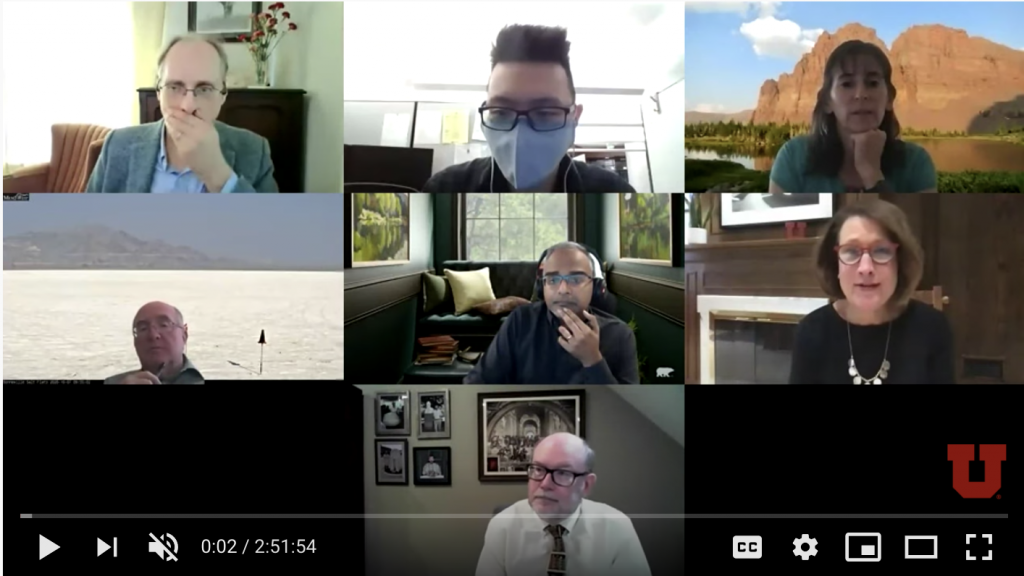Is the University of Utah already a Public Interest Technology university?
The first Utah Informatics Initiative (UI2) fall semester symposium suggests it might be. A virtual gathering held on Oct. 28 highlighted the work of several U researchers focused on data-based solutions to challenges facing the communities around the university, including:
- The AQ&U (Air Quality and U) community-engaged environmental sensor network, managed as part of Chemical Engineering Assistant Professor Kerry Kelley’s air quality research.
- Research about the social impact of machine learning and algorithmic fairness from Suresh Venkatasubramanian, a professor in the university’s School of Computing.
- Study of regional climate issues and the degradation of silt crusts around the Great Salt Lake and its effect on air quality in the Salt Lake Valley from researchers in the Department of Atmospheric Sciences, including John Horel, department chair.
- U-Smart (the Utah Smart Energy Laboratory) research into the next generation of resilient and sustainable power and energy systems, led by Electrical and Computer Engineering Associate Professor Masood Parvania.
 Public Interest Technology (PIT) work simply requires using data to make better public policy, said keynote speaker Eric Meyer, dean of the University of Texas at Austin’s School of Information. The term, coined by the Ford Foundation and New America, is meant to capture the study and application of technology to advance solutions to community problems, particularly for marginalized groups. The University of Texas at Austin is part of the Public Interest Technology University Network (PIT-UN), a group of colleges and universities that banded together in 2019 in an academic initiative committed to building on the ethical use of technology.
Public Interest Technology (PIT) work simply requires using data to make better public policy, said keynote speaker Eric Meyer, dean of the University of Texas at Austin’s School of Information. The term, coined by the Ford Foundation and New America, is meant to capture the study and application of technology to advance solutions to community problems, particularly for marginalized groups. The University of Texas at Austin is part of the Public Interest Technology University Network (PIT-UN), a group of colleges and universities that banded together in 2019 in an academic initiative committed to building on the ethical use of technology.
“There’s data everywhere. We all know that,” Meyer said. “But these data have policy implications and political consequences. How do you use data to make better public policy, to change the ways that policy decisions are made?”
To qualify for the new network, a university needs to meet some basic criteria, Meyer said: “As long as you’ve got a unit that thinks inter-disciplinarily, that thinks about public problems and wants to be able to apply technology to solve them, and that is willing to reach out to nonstandard partners to move that forward, you’re well on your way.”
Dan Reed, senior vice president for Academic Affairs, noted the structural obstacles to creating a PIT-focused campus. “These issues are complex, and they require a 360-degree perspective and collaborative forces that span colleges and departments,” he said.
UI2 Executive Director Mike Kirby believes the Utah Informatics Initiative could provide that perspective and collaboration, bringing together university researchers who already are doing PIT-related work, but just haven’t adopted the title. The Utah Informatics Initiative was established by Reed in 2018 as an effort to build on the university’s existing education, research and workforce development strengths in computational and data science. The initiative is funded using annual performance-based funding from the Utah Legislature.
“We are here to enhance inter-disciplinary and cross-disciplinary research and curriculum development efforts at the intersection of technology and policy so U graduates will be prepared to critically assess the ethical, political, and societal implications of new technologies, and then design technologies in service of the public good,” Kirby said. “We believe much of this work is already being done by researchers and educators at the University of Utah, we just need to break down the barriers that keep us working in individual silos.”
Venkatasubramanian believes students are already ahead in the process of thinking about data science as an interdisciplinary force for good in the world.
“Students are naturally talking about broad topics—taking courses in sociology, philosophy, the humanities,” Venkatasubramanian said. “What makes it hard for them is working through the logistics. But there’s a lot of enthusiasm for a more eclectic way of thinking about STEM fields and how they apply to the world around us.”
For more information about UI2, visit informatics.utah.edu or contact Mike Kirby, executive director and professor at mike.kirby@utah.edu.
